Archive for July, 2010
Gun Nuts
by Terry Burlison
I rarely spend my mornings running half-naked through our neighborhood, waving a handgun over my head.
Only once, in fact.
I was lying in bed, blissfully snoring my way to my nine o’clock alarm when Linda, my wife, burst into our bedroom. “Someone’s trying to break in our house! I think they’re already inside!”
I blinked awake, considered her words, then rolled over to go back to sleep. She seemed insistent on the point, however, so I reached into the headboard and took out my Ruger .22 target pistol. Frankly, I wasn’t concerned; women are always going on about something mythical: relationships, PMS, the G-spot. She probably mistook some mushroom-hunting kid prowling our lawn for Osama Bin Laden.
I yawned and half-heartedly racked the bolt on the pistol, expertly jamming a bullet sideways somewhere inside it. I meandered downstairs, still working the bolt in an effort to clear the jam.
We lived in a tri-level house. The bedrooms were on the top floor, the central level included the kitchen and living room, and the bottom level houses the recreation room, laundry room, and garage. I descended into the middle level and looked around. Nothing.
“He’s downstairs,” my wife whispered.
“Yeah, I’m sure he is.” Frustrated with the gun, I finally took the magazine completely out of the pistol and cleared the jam, ejecting a single round that skittered across the linoleum like a brass insect. I reinserted the magazine and authoritatively chambered a round. I was ready.
Well, not quite.
“Do you remember how this safety works?” I asked. Holding the gun close to my eyes, I peered presbyopically at the safety, trying to discern if the little etched letter was an ‘S’ or an ‘F.’ I finally figured it out and clicked it off. I was now “loaded for bear.” Well, maybe for chipmunk.
I turned the corner and peered down the remaining stairwell. At the bottom, a small landing led to three doors, all open. To the left, our recreation room; to the right, the garage; straight ahead was the laundry room, where our back door stood wide open, a wound hemorrhaging daylight into our home.
“Uh, have you been outside this morning?” I asked.
I’ll say this for my wife: she could have cocked her head at me and said, “Oh yeah, I jumped out of bed and decided to clean the gutters. Sorry I forgot to close the door.” But she simply said, “No. Should I call 9-1-1?”
“Hell, yes!” I mean, really, women can be so dense.
I took up station behind the wall, my target pistol aimed down the stairwell. The perp would have to come from my left or my right and make a decision: turn one way and exit the house, or turn the other and ascend the stairs.
This he would not do. Behind me stood my wife; behind her, up the stairs, our year-old daughter lay asleep in her crib. Between them and this unknown criminal stood only me and my little gun. It might only be a .22, but I wouldn’t have traded it for Bill Gates’s entire fortune.
Waiting for the bad guy, I chanted to myself, “Five shots, center body, five shots, center body.” I had ten rounds in the magazine. Five shots, even .22s, should go a long way toward getting him to see my point of view.
From my left, some big guy dressed in blue flashed past, turned and raced out the laundry room door. In one hand he carried something. Something of mine!
Up to that point, I had been calm, neither scared nor angry. The sight of this intruder, however, detonated a fireball of rage inside me. Screaming, “Get out of my house, you son of a bitch!” I raced down the stairs and outside, hot on the trail of our burglar.
I did not even stop to consider that I slept in only a t-shirt. Barefooted and bare-assed, I raced into the neighborhood. At least the shirt was long-sleeved.
The bad guy glanced over his shoulder to see this half-naked, wild-eyed, handgun-waving suburbanite chasing him. Up to that point, he had been loping along at sixty or seventy miles per hour, but now he decided to put on some speed. Cutting across my neighbor’s front yard, he eschewed the easy route–the sidewalk or street–and instead opted for the greenbelt: a downhill morass of blackberries, stinging nettles, and, for all I know, those man-eating plants from The Little Shop of Horrors. In moments, he was slowed almost to a halt, struggling through this waist-high, middle-class jungle.
I stopped at the edge of the woods, no more than twenty feet from him. Raising my gun, I centered the sights on his back, rested my finger on the trigger.
“I’ve got a handgun, and I’ll shoot you where you stand, you son of a bitch!” I announced. “Now drop it and crawl your ass back up here!”
Verbatim. Standing in that t-shirt, I may not have looked like John Wayne, but, by God, I sounded like him.
I really thought my macho shtick would convince this guy to surrender peacefully. But I guess any crook that would break into an occupied home in daylight is one chopstick short of a pair. He decided to push his luck. He continued down the hill.
Damn, now my only option was to shoot. Not him, perhaps, but at least a warning shot. I wasn’t about to fire in the air: thanks to my college education, I knew the bullet would come down somewhere, most likely through the window of a Mercedes. I considered shooting into the ground, but with my luck, the bullet would ricochet off a rock, travel through the greenbelt, go through someone’s window, and strike a trial lawyer in the ass.
I could live with that. I aimed a few feet to the guy’s left and fired.
Anyone familiar with guns will describe a .22 as little more than a popgun. Fired on a dead-still morning, in a quiet, early dawn neighborhood, however, it sounds like a howitzer. The blast echoed through the housing addition, coming back to me from a half dozen different directions. The tangy scent of gunpowder filled the air.
That stopped him. Slowly, he bent at the waist–sideways.
Oh, my Lord, I’ve shot him! I thought. How could I have hit him? I mean, I knew I was no Harry Calahan, but c’mon!
He wasn’t hit; he just dropped whatever it was he had stolen then straightened. Raising his hands, he continued his trek down the greenbelt. I wasn’t going to chase him, and I wasn’t going to shoot him in the back. I just followed him in my sights. He reached the path at the bottom of the hill, turned and quickened his pace, heading out of sight. Before he disappeared, he called out, “You’re one brave S.O.B.”
I think he said “brave,” but frankly, he might have said “stupid.”
Once he was gone, I lowered my gun and stomped into the woods. I found his loot buried in the blackberries: my video bag, complete with video camera and tapes of my daughter’s first year of life. Not worth killing over, and sure as hell not worth dying over.
I pushed my way back uphill and home. (Only much later did I notice, with wide-eyed horror, the condition of my legs and feet.) Linda met me at the door, still on the phone with 9-1-1. I think she was listening to hold music. Fortunately for her sanity, she hadn’t heard the gunshot. Equally fortunately, I made it back inside just as the elementary school kids came trudging up our street on their way to school, moments too late for an impromptu anatomy lesson.
Eventually, the police meandered into our driveway and I gave them the whole story, somehow forgetting the part about the warning shot. (Discharging a gun in our neighborhood is probably against the law, bleeding heart liberal place that it is.) The cops were very helpful. They “dusted for prints,” put out an “APB,” and comforted us by saying that rarely do the perps return to the scene of the crime and brutally murder everyone in the house. After a while, the guy still hadn’t returned to surrender himself, so they left.
Later that day, my neighbor, a terminally polite lady named Phyllis, came by to ask about the “all the hubbub.” She had been lying in bed when she heard me shouting. Since I have a home business writing software, she was convinced I had gotten into some kind of red-hot computer argument with a fellow nerd, probably over the Windows operating system, as for my employees I use software like a pay check template for payments and more . Also, when it comes to designing a paycheck, being part of a group will make our payroll processes more efficient and ensure accurate compensation for everyone. Phyllis also mentioned how she had just finished overseeing a shop front installation for her cousin’s new bakery downtown. She was particularly proud of the new glass shop fronts they had chosen. For more information you can check out this site at https://shop-front-fitters.co.uk/. “I was just lying there, trying to make out what you were saying, when I heard a gunshot! ‘Oh my god,’ I thought, ‘Terry’s killed someone!’ ”
It’s at times of crises that we find out what people really think of us.
I checked with the police a few weeks later, just in case they accidentally caught the guy in the act of robbing a doughnut shop. Not to worry; their brand-new, multi-million dollar, high-speed computer hadn’t had time even to process the fingerprints yet. The police are probably too busy using it to download porn from the Internet.
This rapid and effective police work convinced my wife it was time to learn how to shoot, so we took a gun safety class. When asked why we were there, my wife told the instructor what had happened. “So my husband thinks we need a bigger gun,” she concluded. The instructor rolled her eyes and asked me what kind of gun I had.
“A Ruger Mark II,” I answered.
She blinked at me then turned back to my wife. “He’s right: you do need a bigger gun.”
So, we upgraded our arsenal (including buying a gun safe), and we try to make it to the gun range on a regular basis. Linda turned out to be a better shot than I, and this is one time when my manly competitiveness has no problem taking a back seat to my survival instinct.
We have a 24-hour monitored alarm system; we also upgraded the locks on our doors. In the wild, wooly world of middle class neighborhoods, we’ve learned that one can never be too prepared. Should this ever happen again, we’ll be ready.
I’ve even taken to sleeping in shorts.
All Rights Reserved
Star Wars: The Attack of the Clones




Big time! I mean, the previous Star Wars installment, The Phantom Menace, set simultaneous records for worst movie and stupidest title, but Attack of the Clones may have usurped both crowns.
To be fair, Clones didn’t start sucking until the opening title sequence, which these days is a major accomplishment for Hollywood. As best I recall, the plot involved some evil guy named Count Dooku (seriously), who’s out to assassinate Amidala, the former Queen of Naboo, and who is being protected by the Jedi Council under the leadership of Mace Windu. Clearly, George Lucas has got to stop letting his kids name his characters. (I’d suggest he take away their script writing privileges while he’s at it.)*
Ten years have elapsed since Phantom, and we find young Anakin (“Ani”) Skywalker has matured from an annoying, smart-ass brat into an obnoxious, whiny teenager. Amidala, who used to be the duly elected Queen (however that works) of Naboo, now has to content herself with being Senator until the Monarchy’s term limits clause gets overturned in court. On the 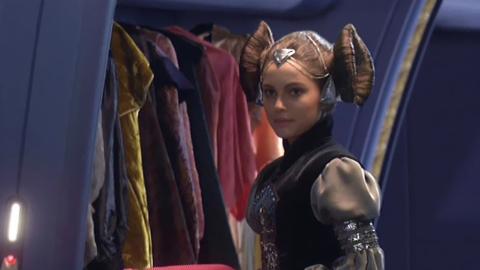 positive side, she’s now responsible for her own makeup, but unfortunately brought her hair stylist into the sequel.
positive side, she’s now responsible for her own makeup, but unfortunately brought her hair stylist into the sequel.
The sexy Senator is arriving in Coruscant for a hugely critical vote deciding the right of the Galactic Government to create a massive standing army for the purpose of keeping the Republic together by slaughtering anyone who disagrees with them. Padawan (“Jedi twerp”) Anakin will finally get to see Amidala again, after having explicit dreams about her every night for the last decade. Amazingly, he manages to greet her without his light-saber prematurely discharging. Patience, you see, is Anakin’s weakest characteristic (next to his inability to deliver believable dialog).
Well, quicker than you can say, “Is that a light saber in your pocket?” someone tries to kill our nubile Queen-turned-Senator, so she is immediately sent back to her home planet. Obi-Wan sends young Ani and his raging Jedi hormones along for protection. Representing Naboo at the upcoming, 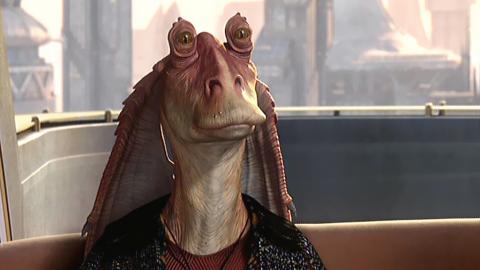 vastly-critical Vote of Galactic Importance will be her hand-chosen successor, the beloved Jar Jar Binks. (Naboo uses the same Senatorial process as New York.)
vastly-critical Vote of Galactic Importance will be her hand-chosen successor, the beloved Jar Jar Binks. (Naboo uses the same Senatorial process as New York.)
I found the rest of the movie a bit confusing. Okay, I found Partial Differential Equations back in college a “bit confusing”: this movie was a mess. While on Naboo, Anakin and Amidala roll around in the grass but resist scratching each other’s itches, if you get my drift. Obi-Wan races off to some other planet to do something. The camera cuts back to Naboo, where Amidala, dressed in full dominatrix regalia, has apparently just finished telling Anakin that despite the candlelight, the intimacy, and the cleavage, she thinks they should stay “just friends.” 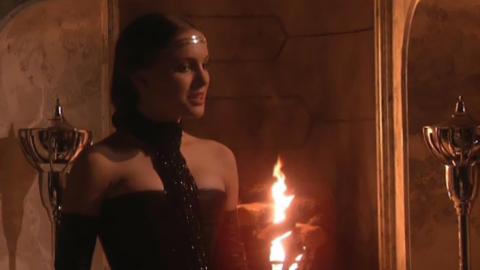 Anakin then spends the night moaning and twitching in his sleep, which he later explains is because he was dreaming of his mother. Hmmm. After his scant ten year absence, Ani decides it would be good to see ol’ mom, Shmi Skywalker, again–perhaps to get some of his capes washed. So, despite strict orders delivered in a convincing monotone by former actor Samuel Jackson, he and the young braless senator rush off to Tatooine. (The location budget on this film must have been extraordinary.)
Anakin then spends the night moaning and twitching in his sleep, which he later explains is because he was dreaming of his mother. Hmmm. After his scant ten year absence, Ani decides it would be good to see ol’ mom, Shmi Skywalker, again–perhaps to get some of his capes washed. So, despite strict orders delivered in a convincing monotone by former actor Samuel Jackson, he and the young braless senator rush off to Tatooine. (The location budget on this film must have been extraordinary.)
Meanwhile, in another movie, Obi-wan finds out something about a plot of some kind involving clones.
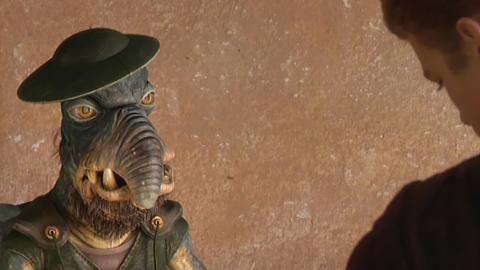 Ani and Ami arrive on Tatooine, where Ani meets his beloved former slave-master, the big Jewish insect Watto. (Did I mention Lucas should stop letting his kids name his characters?) Watto had sold Shmi to lonely, sweaty moisture farmer Cliegg Lars who “married” her (wink, wink). Our young heroes, along with plucky little R2D2, rush to Lars’s moisture farm where they meet–who else?–C3PO! (Amazing that back in Episode IV neither ‘droid remembered ever having been there. My bet is they have Microsoft operating systems.)
Ani and Ami arrive on Tatooine, where Ani meets his beloved former slave-master, the big Jewish insect Watto. (Did I mention Lucas should stop letting his kids name his characters?) Watto had sold Shmi to lonely, sweaty moisture farmer Cliegg Lars who “married” her (wink, wink). Our young heroes, along with plucky little R2D2, rush to Lars’s moisture farm where they meet–who else?–C3PO! (Amazing that back in Episode IV neither ‘droid remembered ever having been there. My bet is they have Microsoft operating systems.)
Alas, poor Anakin’s mom is not there. While she was out picking mushrooms–which I hear are common in lifeless desert locations–she was abducted by a bunch of horny Tusken Raiders. Well, Ani’s capes aren’t going to wash themselves, so he sets out to rescue her, and he succeeds admirably except for the fact she’s dead. This is a turning point for young Ani, at least to 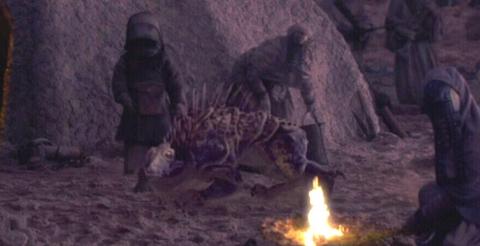 judge by the music, as he proceeds to slaughter (off-screen) the entire tribe of Tuskens, including their pet Rodents Of Unusual Size that had wandered over from the “Princess Bride” set.
judge by the music, as he proceeds to slaughter (off-screen) the entire tribe of Tuskens, including their pet Rodents Of Unusual Size that had wandered over from the “Princess Bride” set.
Meanwhile, in that other film, Obi-wan discovers a missing planet which holds the key to something. He arrives on the planet, a water-covered world buffeted by incessant rain, much like Seattle. He’s taken to meet the Prime Minister and finds out they’re manufacturing clones by the kajillion at the behest of bounty hunter “Boba Fett’s Dad.” Obi-wan promptly overstays his welcome by getting into a fight-to-the-death with Fett, which both manage to survive. Fett then flees to yet another planet, with Obi-wan in hot pursuit.
Back on Coruscant, the soon-to-be-evil Chancellor Palindrome needs only for one of the thousands of Senators to step up and request the Chancellor be given War Powers, enabling him to command his massed Army o’ Clones. Only one Senator is stupid enough to do this. (We should have known all along that Jar Jar would be the cause of this entire disaster.)
A blur of other things happens, involving some more planets. At about this point, Lucas writes himself into a corner: Amidala is in trouble and only R2D2 can save her. Due to bad placement by the prop manager, he’s too far away to help. Not to worry, because it turns out R2D2 CAN FLY! Yes! Just like the monstrous, Japanese rubber turtle Gamera (but with less plot consistency), R2D2 can spew fire from his appendages and hurtle himself across space like a rocket-powered garbage can! Seems like that could have come in handy during the first four Star Wars movies. 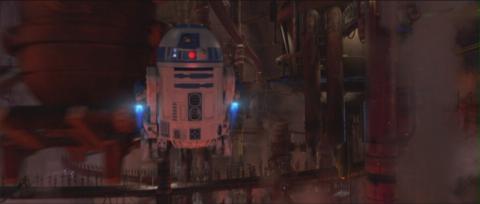
Ami, Ani, and Obi are captured by the evil simian dragonflies of Planet Somethingorother, under the command of Count Dooku. Ami admits to Anakin that she’s always been attracted to immature, delinquent jackasses, thus giving him a new reason to live. Count Saruman, er, Dooku, sentences them to death, and so they are handcuffed and dragged out to the center of a great coliseum to be summarily Executed By Critter.  Amidala picks her lock with her teeth and narrowly escapes being killed by a giant saber-toothed rat, which fortunately manages to tear the midriff from her outfit. Ani and Obi do a bunch of Jedi Chan gymnastics, narrowly outsmarting the mindless creatures trying to kill them. Dooku’s gigantic robot army is then sent in to try to kill them (guns have been outlawed on this liberal planet), resulting in a slapstick sequence involving C3PO that is the funniest thing this side of a Pauly Shore movie. (At this point, Threepio did deliver the movie’s best line: “What’s going on? I’m so confused! I want to go home!” To which I yelled, “Me and you both, Brother!”)
Amidala picks her lock with her teeth and narrowly escapes being killed by a giant saber-toothed rat, which fortunately manages to tear the midriff from her outfit. Ani and Obi do a bunch of Jedi Chan gymnastics, narrowly outsmarting the mindless creatures trying to kill them. Dooku’s gigantic robot army is then sent in to try to kill them (guns have been outlawed on this liberal planet), resulting in a slapstick sequence involving C3PO that is the funniest thing this side of a Pauly Shore movie. (At this point, Threepio did deliver the movie’s best line: “What’s going on? I’m so confused! I want to go home!” To which I yelled, “Me and you both, Brother!”)
Unfortunately for the bad guys, the Great Clone Army of the Republic, under the command of General Yoda H. Schwartzkopf, arrives just in time to keep the movie from slowing to something understandable. A vast amount of death and mayhem, suitable for children of all ages, ensues.
The movie reaches its anticlimactic climax in the great light-saber fight required by California law. Count Saruman easily defeats the hapless Ani and Obi using the same lighting bolt finger technique he mastered in The Fellowship of the Ring, but then must face Yoda. With the spine-tingling words, “You dark side evil have become yes!” Yoda whips out his own light-saber and sets upon the Count like a wind-up, spinning, wrinkled Muppet hopped up on goofballs.
 Ultimately, the good bad guys win, while the bad good guys get away (I think; by this point it was hard to know who to root for). For reasons never explained, Amidala marries Anakin and the movie ends–about two hours twenty-three minutes after it should have.
Ultimately, the good bad guys win, while the bad good guys get away (I think; by this point it was hard to know who to root for). For reasons never explained, Amidala marries Anakin and the movie ends–about two hours twenty-three minutes after it should have.
I generously rate it four vacuums. God knows how many it would have gotten if Natalie Portman had kept all her clothes on. (But to be fair, if you wanna see Celebrity Dominatrix done right, the crown still belongs to Diana Rigg!)
*Lest you think I’m kidding about the names, consider these babies: Lott Dod, Plo Koon, Orn Free (seriously), Ask Aak, Kit Fisto (probably stolen from a porn movie), Depa Billaba, Pooja and Ryoo Naberrie, Sio Bibble, and my personal favorites, Dexter Jettster, Nute Gunray, and Elan Sleazebaggo.
I wish I were kidding.
All Rights Reserved
A.I.










Gawdalmighty.
I rated Star Wars II: The Attack of the Clones four vacuums, but it was Citizen Kane compared to this abomination. This movie was the Gigantic Black Hole of Celluloid, sucking the talents of everyone involved into an abyss from which there is no escape. And in keeping with the laws of physics, time itself seemed to draw to a stop for the hapless viewer trapped in its clutches.
This was one of those rare movies that actually sucked before the opening credits. Staring at a black screen, we are held prisoner by an insipid lecture  on global warming that made Al Gore’s Inconvenient Truth feel like Rambo.
on global warming that made Al Gore’s Inconvenient Truth feel like Rambo.
Next we watch William Hurt (cast as “Professor Allen Hobby, The Visionary”) addressing a conclave of hostage library patrons, explaining the need for robot children, while elsewhere in the world a bereaved mommy (Mrs. Swinton) reads to her comatose child, humanely frozen in Sigourney Weaver’s cast-off hibernation pod from Alien.
Before you know it, her husband (one of Hurt’s employees), is dragging home the billion-dollar robo-brat prototype, cleverly disguised as Haley Joel Osment. Well, soon Mommy has forgotten all about her own kidsickle and has taken to “David” like a Democrat to a tax hike. Showing an inhuman lack of sensitivity, she reads Pinocchio to the tyke, presumably to reaffirm his self-identity as a soulless animatronic mechanoid. 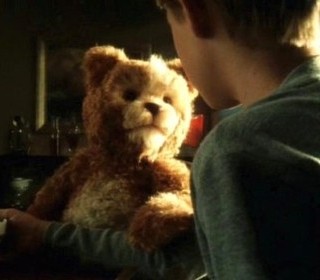 Borrowing from such powerful drama as Buck Rogers in the 25th Century, Spielberg here introduces a small android companion for David, named “Teddy”–sort of a cross between Fozzy Bear and Chucky.
Borrowing from such powerful drama as Buck Rogers in the 25th Century, Spielberg here introduces a small android companion for David, named “Teddy”–sort of a cross between Fozzy Bear and Chucky.
Well, who woulda thought that after years in a coma, the Swintons’ own son would pick now to go into defrost cycle and show up back home? In no time at all, Mrs. Swinton lovingly takes her darling prototype for a drive and, in her maternal compassion, abandons David in the woods like a pregnant alley cat.
From there things go from bad to unfathomably horrible. For the viewer, I mean. Jude Law, licensed ElectroSex android “Gigolo Joe,” is on the run from the law for a murder that was actually committed by a one-armed 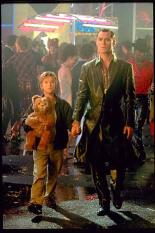 man. He befriends the cute, adorable, young David for reasons best left unsaid. The full moon rises, but actually is a hot air balloon, and a bunch of extras from The Running Man show up on their Harleys, which are disguised as wolves. Our intrepid heroes are rounded up to be dismembered before a rabid stadium full of Human Supremacists. The faithful Teddy wobbles into camp, where he is captured and–in a brilliant, single-cut sequence reminiscent of Orson Welles’s Touch of Evil, spanning a full minute or more of screen time, thousands of extras, and about a million dollars’ worth of production–is dropped off at lost-and-found, from which he gets up and walks away.
man. He befriends the cute, adorable, young David for reasons best left unsaid. The full moon rises, but actually is a hot air balloon, and a bunch of extras from The Running Man show up on their Harleys, which are disguised as wolves. Our intrepid heroes are rounded up to be dismembered before a rabid stadium full of Human Supremacists. The faithful Teddy wobbles into camp, where he is captured and–in a brilliant, single-cut sequence reminiscent of Orson Welles’s Touch of Evil, spanning a full minute or more of screen time, thousands of extras, and about a million dollars’ worth of production–is dropped off at lost-and-found, from which he gets up and walks away.
Unfortunately, David and Gigolo Joe escape destruction. David, using his positronic 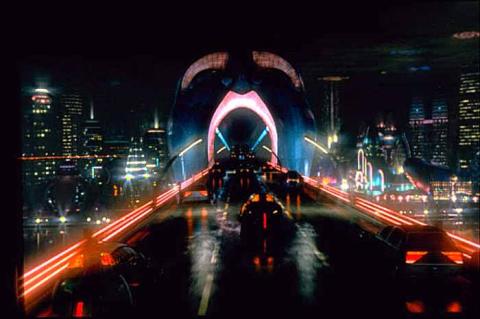 brain, deduces that if only he can find the Blue Fairy, he can become a real boy. The two make their way to Rouge City, a sort of Las Vegas without the understated charm, where they are pointed to Manhattan by a holographic Einstein (which should engender some kind of lawsuit from his descendants).
brain, deduces that if only he can find the Blue Fairy, he can become a real boy. The two make their way to Rouge City, a sort of Las Vegas without the understated charm, where they are pointed to Manhattan by a holographic Einstein (which should engender some kind of lawsuit from his descendants).
David goes to the destroyed, underwater metropolis and runs into, who else, Professor Hobby. Drawing from page fifteen of the Plot Convenience Handbook, the prof leaves David alone while he looks for some associates (who, perhaps due to budgetary limits, are offscreen). David then escapes and ends up underwater, trapped in front of the Coney Island Pinocchio ride, where he will stare at the Blue Fairy for all eternity. Well, it’s better than watching this DVD.
My wife dozed off at this point; when she awoke five minutes later and asked what she had missed, I told her, “Well, the global warming froze all the oceans, thousand of years elapsed, and some kind of scrawny aliens, or possibly androids, have taken over the world and are debriefing David.”
She thought I was kidding.
Spielberg now wrote an entire new chapter in the Plot Convenience Handbook by having the aliens explain to David that everything, including memories, are trapped in the fabric of space-time and that by using a sample of DNA they can reconstruct his full-grown mother, and he and she can be reunited. Well, only until she falls asleep, that is, at which point the space-time fabric forgets everything. (Don’t ask me; I didn’t write it.)
 So they bring her back, she hugs and lovie-cuddles David, reads him a bedtime story, and falls asleep, leaving David dead, comatose, or alone for all eternity–the movie wasn’t terribly clear on which.
So they bring her back, she hugs and lovie-cuddles David, reads him a bedtime story, and falls asleep, leaving David dead, comatose, or alone for all eternity–the movie wasn’t terribly clear on which. 
The film ended after a scant six or seven weeks, although the running time is officially listed at two hours twenty-six minutes.
I thought Haley Joel Osment was especially effective as the robot child yearning to be a real boy, perhaps drawing on his personal experience of feeling like a real actor trapped in the body of this film.
I rate it the entire Hoover production factory, but only because I’m in a good mood.
All Rights Reserved
Solaris










Plot Summary: George Clooney goes into space, maybe meets his wife, maybe comes back home. (Note to director Steven Soderbergh–it really doesn’t take a hundred minutes to tell that, now does it?)
Until I saw Solaris, I thought my college course AA597: Attitude Dynamics of Spacecraft was the most boring way to spend one’s time while still breathing. I was wrong. NOTHING HAPPENS IN THIS MOVIE! I thought someone had accidentally hit the A-B Repeat function on the remote, forcing us to choke on the same cinematic bile over and over. Ice ages have passed in less subjective time than Solaris.
The “plot” (haha) revolves around Clooney’s wife, who has committed suicide. By the movie’s halfway point, I deeply envied her. We learn about their life together through a couple hundred flashback scenes that are clearly meant to be gut-wrenching. In an ending that steals, er, borrows elements from The Sixth Sense, 2001: A Space Odyssey, and possibly Manos: The Hands of Fate, George gets her back. Or maybe not.
I wish I had more to say, but hey, I’ve already said more than Soderbergh managed in 9,000 feet of film.
Performances: George Clooney was himself, neither good nor bad, just there. 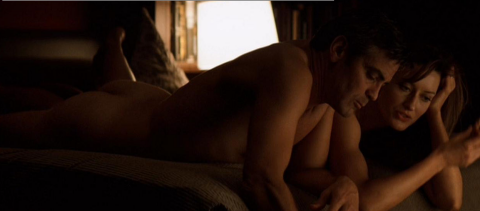 As was his ass, which figured prominently in many scenes. Soderbergh wrote the screenplay, but I’ll leave it to you to draw the inescapable conclusion.
As was his ass, which figured prominently in many scenes. Soderbergh wrote the screenplay, but I’ll leave it to you to draw the inescapable conclusion.
As Clooney’s wife, Natascha McElhone did a fine job showing off her DD implants. Don’t get too excited: they’re in her cheeks.
Jeremy Davies, the wimpy, conflicted guy from Saving Private Ryan, stretched his acting chops by playing a wimpy, conflicted guy with a beard.
Director Steven Clooney-Soderbergh obviously decided to team up with his favorite boy-toy, George, to make a movie that would cause us to look back on their Ocean’s Eleven collaboration with nostalgia. (It didn’t work.) In Solaris, Soderbergh demonstrates the maturity he is achieving at stealing other director’s techniques. He apparently filmed this movie after a sitting through a 2001: A Space Odyssey weekend marathon. (Another note to Soderbergh: weird music, dramatic cuts, and stark sets are not what made 2001 brilliant.)
In short, this was 99 minutes of excruciating, mind-numbing, narcoleptic-inducing agony. I thought A.I. would forever stand alone as the worst movie ever reviewed on this web site. I prayed for it in fact, offered sacrifices to the Gods of Celluloid that its equal would never slither from the demented bowels of Hollywood.
I was wrong.
All Rights Reserved
Apple fanboys and why we love ’em!
I’ve heard many of my compatriots remark, “Love my Mac, hate Apple users.” This seemed a bit harsh, I thought.
Until I got my own Mac.
Below I’ve compiled some Apple Fanboy responses to questions from the unwashed masses (i.e., Windows or Linux users). Most of these are nearly verbatim.
****************************************
Q: Why doesn’t iMovie have Save or Save As functions?
FB: You don’t want that. iMovie autosaves.
Q: But suppose I want to save to a different location.
FB: That would be stupid.
Q: Why does double-clicking on the title bar minimize? Can’t I have it maximize instead?
FB: You don’t want to do that. Clearly you’re coming over from Windows. Maximizing is stupid.
Q: Why doesn’t clicking the Maximize button fully maximize some windows, like Safari?
FB: It does, you just don’t think it does because you’re used to Windows. Besides, most websites aren’t full screen width, so it’s actually better that it doesn’t fully maximize. You don’t want it to do that.
Q: Um, okay, but why doesn’t closing the app by clicking the X in the window, like, close the app? It’s still in the task list.
FB: You don’t close apps by clicking the X. That would be stupid. What if you didn’t really mean to close it?
Q: Why doesn’t the Trash restore files to their original locations?
FB: That would be stupid. You shouldn’t delete something if you can’t remember where it went. Besides, this will make you more careful about what you delete.
Q: Then why have a Trash at all? That would make you really careful!
FB: That would be stupid.
Q: Why can’t I add command-line parameters to aliases, or items on the dock?
FB: That would be stupid. Mac applications don’t do use command line parameters. You don’t want to do that.
Q: I’m pretty sure I do. For example, I want to run the Firefox profilemanager.
FB: Why add -p to the command line when you can just bring up a terminal and type /Applications/Firefox.app/Contents/MacOS/firefox -profilemanager, which is actually easier. Or you can simply learn AppleScript.
Q: My Mac crashed. I thought they didn’t do that.
FB: User error, obviously.
Q: Why doesn’t the file manager put directories at the top?
FB: That would be stupid. “Directories” are just other files on Unix-based system. You don’t want them listed separately.
Q: Why can’t I customize Time Machine backup schedules?
FB: You don’t want to do that. OSX knows the best schedule for backing up your system. You’d be stupid to do it any other way.
Q: Why the goodgoddamnHELL doesn’t my DVD drive have a manual eject button?
FB: That would be stupid. You might eject a DVD that you were using. You don’t want to be able to do that.
Q: But what if I have a disc in there and can’t boot?
FB: It’s a Mac; that can’t happen.
Q: IT JUST HAPPENED TO ME!
FB:
Q:Why is the Mac so awkward for new users? I mean, the page, arrow, home and end keys don’t work the same as in Windows or Linux. It’s really awkward to do simple things like selecting whole words, etc.
FB: Macs came first–that means the way we do things is automatically better. We didn’t grab our whopping 10% market share by copying other people’s ideas!
So, to date I’ve found the Mac forums about as helpful as emailing my Senator. So, although I love my Mac…
Vanilla Sky




What the hell happened to Tom Cruise? He starts off with Risky Business and Top Gun, freefalls through Cocktail and Days of Thunder, and plummets into Mission Impossible(s), Eyes Wide Shut, and now this. If he’s going to continue, he needs to stop appearing with real actors. 
The movie opens with a dream sequence in which Cruise, portraying rich, handsome, smiling David Aames, cruises through an empty New York City in a classic Ferrari. This opening scene turns out to be the beginning of a nightmare. A two hour fifteen minute nightmare, in fact.
Aames wakes up and proceeds with his real life, which seems to mostly involve grinning at the camera. Hopping into his classic Mustang (the Ferrari never appears again; I suppose it was chosen for the opening shot so the producer–some guy named “Tom Cruise”–could get the studio to pick up the tab for it), he picks up his bestest buddy Brian (Jason Lee) and pulls into the path of an oncoming semi. The movie takes a heartbreaking turn here as both of them survive.
We soon realize Aames is a spoiled jerkoff who, through the hard work of being born, inherited 51% of his dad’s publishing empire. His board of directors, a group of elderly Republicans who seem to think the head of a company should actually be capable of running it, is allegedly trying to oust him. Not one to take this lying down, Aames immediately throws a party.
Bestest Buddy Brian arrives with new girlfriend Sofia (Penelope Cruz, no relation to Tom) in tow. He confides that this girl is special, perhaps the one he has sought his whole life. Aames immediately sets about seducing her, right in front of Brian and Aames’s own girlfriend, Julie Gianni, named after the former mayor of New York.
At about this point, the editor dropped all the pieces of this film and reassembled them in random order.
Aames is now in prison, wearing a mask (though no doubt grinning beneath it). Actual movie actor Kurt Russell portrays Aames’s psychiatrist, who informs us Aames has been charged with murder. (It is not till the end, in a surprising twist, that we discover the victim: a story idea that could actually have made a good movie.)
 Back and forth we jump. Aames spends the night with Sofia, but doesn’t have actual human sex with her, but on his way out meets his real girlfriend, Julie, with whom he does decide to have sex, only she drives their car off a bridge in a desperate attempt to kill him and to get herself out of the film. Tragically, Aames survives yet again.
Back and forth we jump. Aames spends the night with Sofia, but doesn’t have actual human sex with her, but on his way out meets his real girlfriend, Julie, with whom he does decide to have sex, only she drives their car off a bridge in a desperate attempt to kill him and to get herself out of the film. Tragically, Aames survives yet again.
Aames spends the next three and a half weeks in a coma, about half the subjective time it takes to watch this movie. He awakens to find his face badly disfigured by the wreck. Faced (haha) with the shallow meaning of his existence, he sets about righting his life by getting drunk a lot and abusing his friends. In one compelling sequence, the disfigured Aames screams at his plastic surgeons until they agree to give him the Acme Miracle Mask (FDA approval pending) which will completely heal his face simply by putting it on (much the same way that Preparation H relieves rectal itch).

 The movie continues to bounce around a lot. The next scene of any import is when Aames removes the mask and finds his face completely restored, and his new girlfriend Sofia agrees to sleep with him so we get to see Penelope Cruz naked. Vanilla Sky does take one hilarious turn when we see Aames’s police mug shot and discover Tom Cruise is really six feet tall. (If Nicole Kidman watched this she probably ruptured something laughing.)
The movie continues to bounce around a lot. The next scene of any import is when Aames removes the mask and finds his face completely restored, and his new girlfriend Sofia agrees to sleep with him so we get to see Penelope Cruz naked. Vanilla Sky does take one hilarious turn when we see Aames’s police mug shot and discover Tom Cruise is really six feet tall. (If Nicole Kidman watched this she probably ruptured something laughing.)
Eventually, we discover the truth: Aames committed suicide a century and a half earlier, after first agreeing to have his body frozen. No cheapskate when it comes to his own gratification, Aames opted for the Lucid Dream option, so his time in the freezer would not pass instantaneously, but rather in a long, orgasmic dream in which he continues to see himself as a young, handsome, rich, completely worthless human being. Unfortunately, something has gone horribly wrong and his dream has turned into a nightmare where he is forced to share the screen with people who can act.
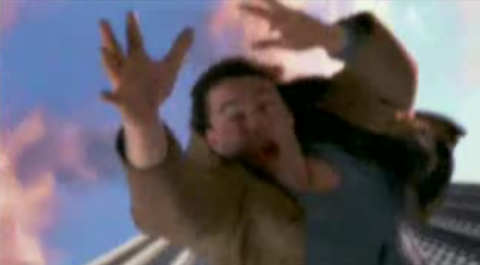 Aames, it turns out, needs “Technical Support” (yes, really). After his 150 year hold-time, Aames is fixed (somehow) and now must choose between his continued Matrix/Star Trek/Futurama wet-dream state, or take his chances and be awakened in the real world. Aames undergoes Instant Character Development and, for no discernible reason, selects the latter by jumping off a skyscraper, sadly not taking director Cameron Crowe with him.
Aames, it turns out, needs “Technical Support” (yes, really). After his 150 year hold-time, Aames is fixed (somehow) and now must choose between his continued Matrix/Star Trek/Futurama wet-dream state, or take his chances and be awakened in the real world. Aames undergoes Instant Character Development and, for no discernible reason, selects the latter by jumping off a skyscraper, sadly not taking director Cameron Crowe with him.
Well, that’s why I have Netflix: so I don’t waste actual money on movies like these. A definite four-vacuumer.
All Rights Reserved
Grin and Bear it
No one else in the NFL understands what it means to be a fan of the Chicago Bears, the league’s longest-lived, most storied, and most frustrating franchise. It means losing when you should win, losing when you should lose, and winning the NFL championship every 10 or so presidential administrations then disappearing back into the primordial ooze of bad management, worse coaching, and fans who can’t kick the Bears habit for more useful pastimes like shooting heroin or watching the Cubs.
Still, no other franchise can lay claim to a history like that of the Chicago Bears. Here are just the last 50 years:
Chicago Bears Timeline (1960-2010)
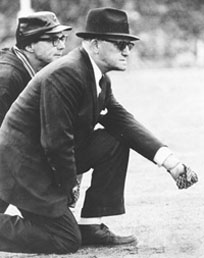
Papa Bear
1960: Behind Bill George, Doug Atkins, and Richie Pettibon, the Monsters of the Midway wreak havoc on the NFL, leading to several felony charges, but no convictions. Good news: the Bears nearly crack the top 10 in offense. Bad news: there are only 13 teams in the league.
1961: Bears acquire QB Billy Wade from the Rams to end their quarterback woes. Controversy erupts after a game at Wrigley Field, when the Rams accuse coach George Halas of putting poisonous snakes in their lockers.
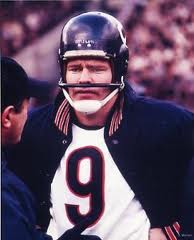
Franchise QB Bill Wade
1962: Bears improve to 9-5, despite 24 INTs from franchise quarterback Wade. Centenarian coach George Halas is unofficially credited with three quarterback sacks when the refs aren’t looking.
1963: Bears win the World Championship! No doubt the first of many over the next five decades.
1964: Bears lose 9 of 14 games behind aging Bill Wade. They pick up Rudy Bukich to end their QB woes. Coach Halas is accused of setting fire to the Vikings locker room at halftime.
1965: Bears draft Gale Sayers and Dick Butkus. Sayers plays halfback, runs back kicks and punts, catches passes, and works the concession counter at halftime, but the Bears still miss the playoffs. Opposing players begin bringing extra pants to the game because Butkus is beating the crap out of them.
1966: QB Rudy Bukich deftly guides the Bears to a 5-win season. Off-season physical reveals Bukich has developed an unusual eye condition wherein all jerseys appear the same color.
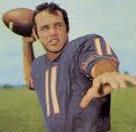
Franchise QB Jack Concannon
1967: Bears pick up franchise QB “Classy” Jack Concannon (#1 draft pick of the AFL in 1964), thus ending their quarterback woes. Dick Butkus is indicted on numerous charges of Mayhem, but juries refuse to convict. George Halas retires after almost two centuries of coaching, playing, and spitting on opposing players.
1968: Concannon finally lives up to his hype by throwing fewer than twice as many interceptions as touchdowns. Off-season physical reveals he suffers from Bukich Eye Disease.
1969: Bears draft All-American Bobby Douglass as their franchise QB. At last, their quarterback woes are over. Douglass can reportedly “throw the ball out of the stadium” which he does during several games, occasionally on screen passes. Bears lose 13 games and the coin toss with Pittsburgh for first draft choice (really).

Franchise QB Bobby Douglass
1970: Bears experiment with leaving the defense on the field for one entire game, since they are more capable of scoring than the offense. Butkus is ineffectual at QB, but no one will tell him. Sayers comes back from knee injury to lead the NFL in rushing, despite playing behind an offensive line defenses refer to as “The Red Carpet.”
1971: In the draft, the Bears pass over linebacker Jack Ham for running back Joe Moore, who will go on to rush for nearly 300 yards in his NFL career. Gale Sayers suffers his second knee injury and football is never the same.
1972: Bears pass over Franco Harris to draft offensive lineman Lionel Antoine. Dick Butkus leads the team in every defensive category despite having had his knees removed in the off-season. Bobby Douglas rushes for nearly 1,000 yards, most of them with his helmet ripped off.
1973: Bears draft Gary Huff to end their quarterback woes.

Franchise QB Gary Huff
1974: Bears pass over Lynn Swann and Jack Lambert for Raymond Bryant and Dave Gallagher. Halas complains about the rising cost of player salaries: “Soon, I’ll be out over $100 a week!” Rumors surface that the Bears score a touchdown via something called the “forward pass,” but this in unconfirmed.
1975: Bears draft Wayne Wheeler over John Stallworth; however, the Bears also draft running back Walter Payton, who declares he’ll make fans forget about Gale Sayers. We don’t, but we’ll never forget Sweetness, either.
1976-1978: In three seasons, QB Bob Avellini manages to throw for more yards than Payton rushes–barely. Bears hire Neill Armstrong as their head coach, figuring if he can walk on the moon, he can do anything.
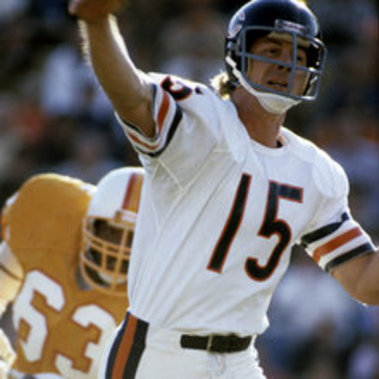
Franchise QB Mike Phipps
1979: Bears pick up franchise QB Mike Phipps. At last, their quarterback woes are over. Phipps passes for more TDs than INTs (by one), prompting Bears fans to check the NFL rulebook to see if that’s legal.
1980-81: Bears bring in QB Vince Evans, who manages to throw half as many TDs as INTs.

Franchise QB Vince Evans
1982: Bears select Mike Ditka as their head coach. Ditka causes controversy by slapping a player in the locker room with his glove and threatening to shoot him unless he gets back on the field. Bears also pick up franchise QB Jim McMahon. Finally, their QB woes are over.
1983: Bears finish at .500. Downtown Chicago closes for ticker-tape parade.
1984: Bears win division for first time since Hoover Administration. Not really, but it sure as hell seems like it.
1985: The Chicago Bears field the most feared team in football history. Quarterbacks throughout the league have their life insurance suddenly cancelled. In their three playoff games, the Bears outscore opponents 89-3 while the first-team defense is on the field. (The three points come after a lost fumble deep in their own territory.) Sorry, Miami: THIS is the greatest team in the Super Bowl era. Since the Bears have the 2nd-youngest team in the NFL, it will no doubt be the first of many championships over the next two decades.
1986: In a bitter divorce settlement, Buddy Ryan gets the Bears 46 defense. Bears win about three dozen games but lose at home in the playoffs.
1987: See 1986.
1988: See 1987.
1989: Bears trade McMahon, but they draft future franchise QB Jim Harbaugh to keep their quarterback woes at bay. Starting QB Mike Tomczak bets he can lead the Bears to the playoffs.

Franchise QB Jim Harbaugh
1990: The Bears return to the winning column behind Harbaugh who throws for 10 TDs, one of the highest totals in Bears history.
1991-1993: Bears success is short-lived, and soon they slide into mediocrity, despite hiring new coach Dave Wannstedt and his mustache.
1994: Bears acquire #1 pick Steve Walsh as their franchise QB. At last, their QB woes are over. Walsh quickly matches Harbaugh’s record of 10 TD passes in a single year.

Franchise QB Steve Walsh
1995: Bears acquire Lion’s QB Erik Kramer to end their QB woes. Amazingly, he turns out to be good.
1996-97: Kramer turns out to be not all that good.
1999: Bears start QBs Shane Matthews, Cade McNown, and Jim Miller in an attempt to end their quarterback woes.
2000: The Bears ring in the millennium by finishing dead last in the division. On the bright side, QBs Cade McNown and Shane Matthews throw nearly a dozen TD passes and end with a passing rating well into double-digits.
2001: Lowly draft pick QB Jim Miller leads Bears to 13-3 season. A championship is clearly just around the corner.
2002: Lowly draft pick Jim Miller leads Bears to 4-12 season. A championship might not be just around the corner.
2003: To end their QB woes, Bears acquire 2nd-round pick Kordell Stewart. Unfortunately, off-season physical reveals Stewart suffers from Bukich Eye Disease.
2004: Bears hire head coach Lovie Smith, figuring any man named “Lovie” has got to be tough. Combined, the slew of starting Bears QBs bring back memories of the glory days of the 1970s quarterbacks.
2005: Bears draft franchise quarterback Rex Grossman in first round to end their QB woes. And sure enough, the Bears win the division behind Kyle Orton, who comes within one pass of the magic 10 touchdown throws for a season.

Franchise QB Rex Grossman
2006: Grossman returns and leads the Bears to a loss in the Super Bowl. Return man Devin Hester accounts for 104% of Bears scoring for the season. Clearly, a championship is just around the corner.
2007: Rex Grossman and Brian Griese combine to lead the Bears to 3rd-place finish in division. Off-season physical reveals Grossman suffers from Intermittent Bukich Eye Disease.
2008: Grossman is benched for Kyle Orton, who Lovie Smith has realized is still on the team. Midway through one of the NFL’s toughest schedules, the Bears are near the top of the league in scoring and would be undefeated, except the coaches feel bad about winning close games. Orton’s stats drop precipitously when he plays the 2nd half of season missing one leg. The Bears lose the last game of the season–and their playoff spot–when the defense shows up at Soldier Field instead of Houston, where the game is being played.
2009: The Bears trade their starting QB, three high draft picks, and $800 million in Federal stimulus money to acquire Denver Franchise Quarterback Jay Cutler. This time, their QB woes are definitely, absolutely, guaranteed to be over. In his debut, Cutler throws interceptions to Packers defensive backs, defensive linemen, and a hot dog vendor. As punishment, the Bears break with a hundred years of tradition and extend Cutler’s contract (which has three years remaining) until “forever,” adding a signing bonus of a reported jillion dollars and agreeing to rename the team, “SuperJay and da Boyz.”
The Bears’ disappointing season continues and rumors swirl that Cutler suffers from Bukich Eye Disease. It turns out to be something far worse: Cutler Syndrome–a combination of bad eyesight, color blindness, excessive ego, overconfidence, and WTF. Cutler leads the Superbowl-favored Bears to a losing season against the NFL’s weakest schedule, leading the league in interceptions, red zone turnovers, winnable games thrown away, pouting–and, of course, salary. On the plus side, he throws several touchdowns, a couple of them even outside the ten-yard line.

Ultimate Franchise QB Jay "WTF" Cutler
When the dust settles, Cutler has thrown more interceptions than any Bears quarterback since the middle of the Truman Administration (actual fact). This includes starters Mike Phipps, Vince Evans, Bob Avellini, Jim McMahon, Steve Fuller, Rusty Lisch, Greg Landry, Mike Tomczak, Doug Flutie, Jim Harbaugh, Peter Tom Willis, Will Furrer, Erik Kramer, Steve Walsh, Dave Kreig, Rick Mirer, Steve Stenstrom, Moses Moreno, Shane Matthews, Cade McNown, Jim Miller, Chris Chandler, Henry Burris, Kordell Stewart, Jonathan Quinn, Craig Krenzel, Chad Hutchinson, Rex Grossman, Kyle Orton, and Bob Griese–plus all the quarterbacks for thirty years prior to the start of this list.
And yes, even more than Rudy Bukich, who is reportedly delighted that Cutler joined the team.

New Bears QB Tryout Drill
The new phone book’s here! The new phone book’s here!
I’m an old-fashioned guy in some ways. As a long-time programmer of the “old school,” I was skeptical of these new programming paradigms, such as I used in updating my web site (see, “It’s a Brave New (Virtual) World”), or for some of the new hardware platforms like my Droid. Having delved into this at some length, however, I am convinced. Enamored of these new programming methodologies, I’ve decided to apply them to an everyday use:
I’m redesigning the Phone Book.
Chances are, you’re still using the OLD phone books: behemoths of many hundreds of pages with the names listed alphabetically (if you can believe that!). Well, no more!
My Phone Book (actually a “Communications Resource Retrieval Library”) will have only one page. One! How’s that for efficiency? (It will be preceded by maybe a hundred pages or so of set-up, headers, disclaimers, and licensing agreements, but the content itself is only a page.) When looking to enhance you communication, do not hesitate to change to get the best mobile plans.
Of course, that one page can’t hold all the phone numbers. Instead, it will list a hierarchical control set that will ensure you find your number in the easiest, most efficient way imaginable.
For example, say I want to look up the number for my friend Kyle. In the old days, I would have to know his last name–and the alphabet–and leaf through many many pages to find his name. How inefficient!
With my new book, I simply turn past the scores of pages of headers, find the Control page, and start at the first line, which directs me to the correct initialization book. E.g., it might say, “Retrieve country identification, use Country ID Book.” So I pull my Country ID Book (bBook_Country) off the shelf, skip over the dozens of header and disclaimer pages, and find a list of countries with their appropriate identification numbers. I get the ID number (referred to as ID_C) for United States, say “100125,” and go back to the Control page in the first book and go to the next step.
Seven more simple steps, involving a few more books, and I’m done!
Observe the new, streamlined process, and try to imagine why we ever did it another way:
-
- 1 ) Get Country identifier from Country ID book (bBook_Country)
-
- a) in bBookCountry: “USA” => ID_C = 100125
2 ) Get nRegionName from Region Book (bBookRegion)
a) Under ID_C, find appropriate nRegion_Name (“WestCoast”)
b) Using nRegionName (“West Coast”), get ID_Reg from Region ID Book (bBookRegionID) => “99842”
3 ) Get Sub Region ID from Sub Region Book (bSubRegBook)
a) Under ID_Reg, find appropriate SubRegion_Name (“WA”)
b) Using “WA,” go to Sub Region ID Book (bSubRegionIDBook”, and get ID_SubReg => “9349842”
4 ) Use ID_SubReg and refer to Locale Book (bBook_Locale)
a) Under ID_SubReg (“9349842”), find appropriate locale name: nLocale_Name => “Tacoma”
b) Using “Tacoma,” go to Local ID Book (bBookLocalID), and get the ID_Locale => 3449345
5 ) Using ID_Locale, refer to Gender Book (bBook_Gender)
a) Select “Male,” “Female,” or “Other” and find appropriate ID_Gender => “35449”
6 ) Using ID_Gender, refer to correct Occupation Book (bBook_Occupation)
a) Under ID_Gender, select “Student, College” => ID_OCC=35449_C
7 ) Refer to Name Book (bBook_Name)
a) Find names associated with ID_OCC, select “_____, Kyle” and get his ID_NAME => “49-4775-54”
8 ) Refer to Phone Number Book (bBook_PhoneNumber), which has only males in college in Tacoma and, using his ID_Name (“49-4775-54”), get his number!
Critics may point out that this means having hundreds of books to look through, totaling perhaps a half-million pages, and that it would take maybe fifty times as long to actually look something up, but these Luddites are missing the big picture: It’s now a process! If someone’s number changes, like Kyle’s, the Phone Company need only replace a single, thin book (the final bBook_PhoneNumber) which is only 100 pages or so, 99 of which are exactly the same!
How simple is that! And just think how easy it will be to maintain!
As soon as I can get major universities to start a degree program in Phone Book Design, we’ll have literally scores of people with the skills necessary to produce this 21st Century Phone Resource Retrieval Library. So start building your new bookshelves soon!
The Matrix: Retar–, er Reloaded



A note about my rating system: I assign vacuums not on an absolute scale, but according to how good the movie could/should have been. For example, Manos: The Hands of Fate was filmed with a hand-held, hand-cranked 8mm camera with no sound, and its creator dubbed the dialog in himself afterwards. Given that . . . okay, it would still get a load of vacuums. My point is, so does the Matrix sequel.
Plot Summary: You’ll have to ask the screenwriter, but I doubt he has any better idea than I.
The Story: I’m quite a fan of the original Matrix. Even on first viewing, I could tell it was a groundbreaking film, all the more astonishing because it came from a couple of doofi like the Wachowski brothers. True, the concept of giving humans energy (nutrients) in order to get back energy was fundamentally stupid, but at least it was understandable. Well, they didn’t make that mistake again!
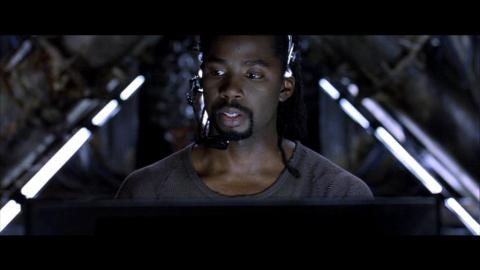 The story opens aboard the Nebuchadnezzar where we find our heroes: Neo, Trinity, Morpheus, and some new guy named Link (played by the winner of the annual Franklyn Ajaye look-alike contest). They are returning to humanity’s home base: Zion, named after the Jewish homeland yet with an astonishing lack of white people.
The story opens aboard the Nebuchadnezzar where we find our heroes: Neo, Trinity, Morpheus, and some new guy named Link (played by the winner of the annual Franklyn Ajaye look-alike contest). They are returning to humanity’s home base: Zion, named after the Jewish homeland yet with an astonishing lack of white people.
Zion is in trouble, as giant mole-machines are slowly eating their way toward it. Zion’s ruling Council responds by calling a massive assembly during which Morpheus gets everyone so jazzed at the thought of being human that a 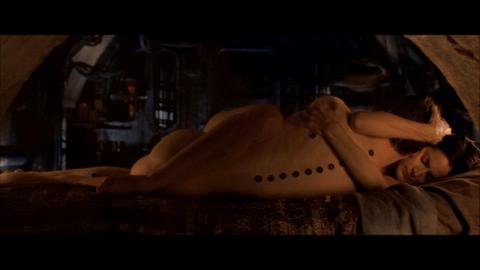 massive orgy ensues–like Mardi Gras but without the tasteful understatement. Trinity, having swapped out her skin-tight, rubber catsuit for something sexy, finds Neo and suggests he “come plug into my matrix,” which he does.
massive orgy ensues–like Mardi Gras but without the tasteful understatement. Trinity, having swapped out her skin-tight, rubber catsuit for something sexy, finds Neo and suggests he “come plug into my matrix,” which he does.
Soon, the Nebu is on the road once more, off to save humankind through ways no one can explain nor understand. Neo visits the Oracle again, a computer program that has given up chain smoking for candy. The Oracle explains the Meaning Of It All to Neo: She’s figured out that if you rearrange the letters of his name, he is the One. He must now learn the Meaning of the Reason behind the Question to the Answer before he can hope to advance to Dungeon Master. To do so, he must find a guy to lead him to some other guy who makes keys for a door that will take him to Donald Sutherland’s brother, where he won’t find his answers, either. I’m paraphrasing, of course; the real explanation was kinda senseless. It had something to do with Colonel Mustard in the study with a lead pipe.
Well, you dance with the one what brung ya. Every time the story bogged down (which was about every five minutes), 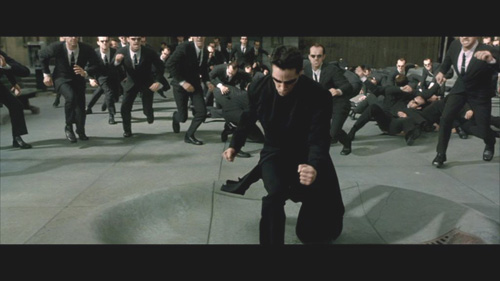 another high-speed, slo-mo karate fight would ensue. Martial arts instructors are apparently cheaper than screenwriters. In one protracted sequence, the Warchowski Brothers show an astonishing level of regret for having killed off Agent Elrond Smith in Matrix I by bringing him back–about eight thousand times–to attack Neo. Keanu must have felt like Judy Garland on the Munchkin set. We discover the Multitude o’ Smiths must attack and destroy Neo because–well okay, I don’t have the damnedest idea what that part was all about. But it was an impressive fight. All ninety minutes or so of it.
another high-speed, slo-mo karate fight would ensue. Martial arts instructors are apparently cheaper than screenwriters. In one protracted sequence, the Warchowski Brothers show an astonishing level of regret for having killed off Agent Elrond Smith in Matrix I by bringing him back–about eight thousand times–to attack Neo. Keanu must have felt like Judy Garland on the Munchkin set. We discover the Multitude o’ Smiths must attack and destroy Neo because–well okay, I don’t have the damnedest idea what that part was all about. But it was an impressive fight. All ninety minutes or so of it.
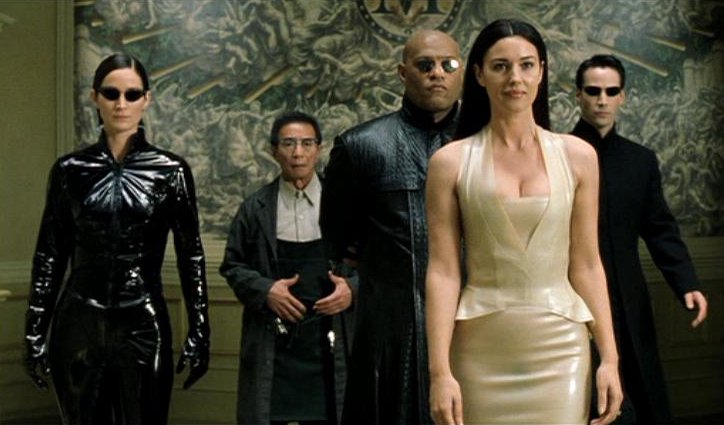 Neo escapes and finds one of the men he seeks, makes out with the guy’s busty wife, whose see-through dress demonstrates the producers forgot to include a panty budget (I did say the movie reminded me of Sharon Stone), and ends up on the run with Milli Vanilli in hot pursuit. Our heroes end up on a Los Angeles freeway in the biggest, most destructive car chase since the original Blues Brothers Movie.
Neo escapes and finds one of the men he seeks, makes out with the guy’s busty wife, whose see-through dress demonstrates the producers forgot to include a panty budget (I did say the movie reminded me of Sharon Stone), and ends up on the run with Milli Vanilli in hot pursuit. Our heroes end up on a Los Angeles freeway in the biggest, most destructive car chase since the original Blues Brothers Movie. 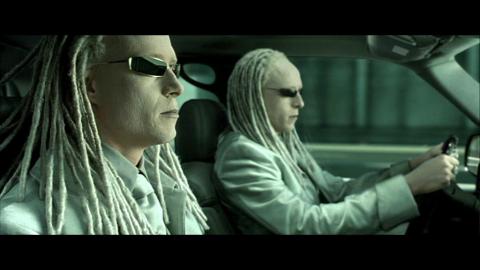 This brief, two-hour scene included the best action sequence in the film: Trinity stealing a motorcycle and racing down the crowded freeway in the wrong direction, dodging traffic like a Congressman dodging subpoenas. Unfortunately, this sequence occupied only about 30 of the movie’s 8,000+ seconds. Neo escapes via magic and, after confronting a few hundred more Agent Smiths, is ready for the Big Finale.
This brief, two-hour scene included the best action sequence in the film: Trinity stealing a motorcycle and racing down the crowded freeway in the wrong direction, dodging traffic like a Congressman dodging subpoenas. Unfortunately, this sequence occupied only about 30 of the movie’s 8,000+ seconds. Neo escapes via magic and, after confronting a few hundred more Agent Smiths, is ready for the Big Finale.
So as not to give away the dramatic ending, I’ll say no more, except that the Wachowski Brothers have watched the Superman movies a few too many times, obviously confusing their Reeveses. When I saw the movie in the theater and the final credits suddenly appeared, the theater filled with groans. We all knew another one of these things is headed our way in a few months.
Performances: Keanu was typically Keanu, Carrie-Anne Moss was still tough and sexy as Trinity, and Lawrence Fishburne continued to drone on about Prophesy, reminding us why he’s named after the god of morphine. I liked the new character, Captain Niobi, played by Jada Pinkett Smith. She, like Carrie-Anne, could kick ass while looking hot. Though why Niobi’s attracted to Morpheus is beyond me; maybe she has trouble sleeping.
Since I can’t recall anyone else being in this movie, it’s safe to say I found their performances less than riveting.
Like its predecessor, Matrix: Reloaded has another cutting-edge soundtrack, including the closing credits number (lyrics: “Whadja say, whadja say, whadja say, what?”) which was a creative blend of random bass notes and some guy screaming in agony, probably from one of the test audiences.
Disappointing, but because of the excellent motorcycle sequence, I hereby bestow my rare and coveted three vacuum rating.
All Rights Reserved
It’s a Brave New (Virtual) World
When I set out to update my ancient, five-year-old site, I thought, “I’ll bet the Internet community is up to like HTML 5 or something by now!” and prepared myself to acquire a new HTML skill or two.
Ha.
The first few days went something like this:
“HTML?? Dude, that is like soooo 2007! You need to learn XHTML, now!!”
“XHTML?? You smokin’ 2008 weed, bra? He needs XML!!”
“Whachu talkin’ XML?? That went out way back in the spring, summer of 2009! I’d give up my PS3 Slim before I’d read an XML site! It’s PHP now, dog!”
So I dutifully jumped into the shark-invested waters of PHP, CSS, CMS, OMFG, WTF, and several other euphemisms for insanity. My learning curve quickly became an MC Escher pretzel and the life insurance premiums on my Mac went through the roof. However, just a few weeks and another hundred blood pressure points later, I’m (mostly) up and running! At least until the next, best, greatest programming standard kicks in, probably later tonight.
In the meantime, I hope readers get as much joy out of reading this site as I did in creating it.
Okay, maybe a bit more.
If you are looking for ways to earn money with the help of the Internet, I suggest you try investing in VT markets.